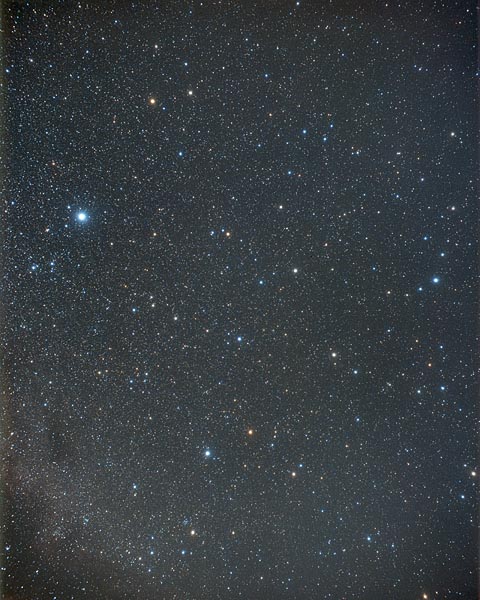DMI image reference Her. « Previous || Next » Constellations A » H || Constellations I » V

Roll mouse over picture to see constellation outlines
Image and text ©2008 Akira Fujii/David Malin Images.
In the picture above north is at the top and the image covers 54.7 x 68.3 degrees.
Image centre is located at 16:56:1.2, +29:23:39 (H:M:S, D:M:S, J2000) Astrometric data from Astrometry.net.
Best seen in the early evening in July
Hercules, the Roman Hero, is best known for his twelve labours, mentioned throughout the Greek constellation legends as Herakles, who is sometimes identified with the much older (5000 BC) Sumerian strong man Gilgamesh. To the Greeks he was the son of Zeus and the earthly queen Alkmene. Zeus' goddess wife Hera was not best pleased and sought to destroy Herakles. Later he was to accomplish eight heroic acts as well as his famous 12 labours, these last perhaps representing the Sun's passage through the zodiacal constellations. There's quite a bit more about this in Wikipedia.
The constellation is the fifth largest in the sky but does not catch the eye and has no bright stars rivaling Vega in adjoining Lyra or even the much fainter Gemma in Corona Borealis to the west. However, there are many interesting double stars in Hercules as well as the northern hemisphere's finest globular cluster M13.
Named stars in Hercules (Greek alphabet)
al Jathiyah (ι Her), Kajam (ω Her), Kornephoros (β Her), Marfik (κ Her), Maasym (λ Her), Rukbalgethi Genubi (θ Her), Ruticulus (ζ Her), Rasalgethi (α1 Her), Sarin (δ Her), Sofian (η Her).
Constellations adjoining Hercules
Boötes, Corona Borealis, Draco, Lyra, Ophiuchus, Sagitta, Serpens, Vulpecula.